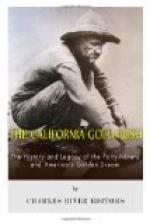Truth to tell, the newcomers of this last class were not personally objectionable to the Californians. The Spanish considered them no different from those of their own blood. Had it not been for an uneasiness lest the enterprise of the American settlers should in time overcome Californian interests, had it not been for repeated orders from Mexico itself, and had it not been for reports that ten thousand Mormons had recently left Illinois for California, it is doubtful if much attention would have been paid to the first immigrants.
Westward migration at this time was given an added impetus by the Oregon question. The status of Oregon had long been in doubt. Both England and the United States were inclined to claim priority of occupation. The boundary between Canada and the United States had not yet been decided upon between the two countries. Though they had agreed upon the compromise of joint occupation of the disputed land, this arrangement did not meet with public approval. The land-hungry took a particular interest in the question and joined their voices with those of men actuated by more patriotic motives. In public meetings which were held throughout the country this joint occupation convention was explained and discussed, and its abrogation was demanded. These meetings helped to form the patriotic desire. Senator Tappan once said that thirty thousand settlers with their thirty thousand rifles in the valley of the Columbia would quickly settle all questions of title to the country. This saying was adopted as the slogan for a campaign in the West. It had the same inspiring effect as the later famous “54-40 or fight.” People were aroused as in the olden times they had been aroused to the crusades. It became a form of mental contagion to talk of, and finally to accomplish, the journey to the Northwest. Though no accurate records were kept, it is estimated that in 1843 over 800 people crossed to Willamette Valley. By 1845 this immigration had increased to fully 3000 within the year.
Because of these conditions the Oregon Trail had become a national highway. Starting at Independence, which is a suburb of the present Kansas City, it set out over the rolling prairie. At that time the wide plains were bright with wild flowers and teeming with game. Elk, antelope, wild turkeys, buffalo, deer, and a great variety of smaller creatures supplied sport and food in plenty. Wood and water were in every ravine; the abundant grass was sufficient to maintain the swarming hordes of wild animals and




